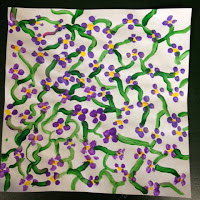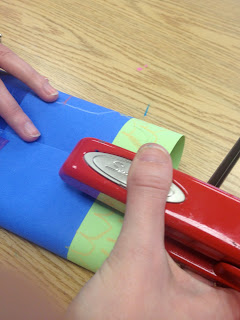The inspiration for the cranes came from the story of Sadako Sasaki. Sadako was just 2 years old when the first atomic bomb was dropped near her home in Hiroshima. Though she and her family survived, Sadako later succumbed to radiation sickness in the form of leukemia. While receiving treatment in the hospital, she and her roommate began folding paper cranes as per the Japanese legend that folding 1,000 paper cranes would make one's wish come true. Sadako died at just 12 years old, yet her memory lives on through her story, as well as the statue dedicated to her at the Hiroshima Peace Memorial Park.
Some of my fifth grade history buffs were eager to tie an art project into their knowledge of World War II, and all students respectively watched the following video to learn about Sadako:
Students spent the rest of their class studying examples of traditional origami paper, then painted a sheet or two of 9 x 9" one-sided fadeless paper to make their own.
On the second day (our classes are 45 minutes each), I walked kids through the folding of a paper crane. (My student teacher made a rockin' PowerPoint to walk the kids through this, but if you need a tutorial for yourself, you can find a few on YouTube.) The kiddos did an awesome job and were thrilled with the way the wings of the crane flapped! I'm always impressed with the way some students pick up the folding steps and can whip up their own pieces after seeing the how-to just once.
What quickie projects do you turn to at year's end? I'll soon be starting a Pinterest board with ideas and would love to add yours!































































